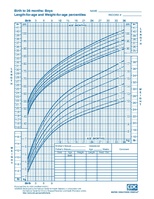
Photo from wikipedia
Background Growth faltering is commonly encountered in breastfed infants during 4—6 months of age in low socioeconomic communities. The objective of this study was to describe the changes of growth indices… Click to show full abstract
Background Growth faltering is commonly encountered in breastfed infants during 4—6 months of age in low socioeconomic communities. The objective of this study was to describe the changes of growth indices with age, timing of growth faltering and its association with the feeding practices in children up-to 18 months of age. Methods A cross sectional descriptive study was conducted in 254 children aged 12 and 18 months attending an immunization clinic. Data on growth were extracted from the Child Health Development Record. Weight and length were measured using standard methods. Feeding practices were assessed using interviewer-administered questionnaire. A drop of > 0.25 in weight-for-age Standard Deviation Score (SDS) from birth SDS was defined as weight faltering. Results Weight faltering occurred at some point in 64.2% ( n = 163) during first 18 months of life, and 78.5% of whom, had the onset ≤ 4 months of age. Majority (76.6%, n = 98) with weight for age faltering by 4 months remained so at 12 months ( p = 0.497), while 29.7% ( n = 38) had a weight-for-length below-2SD ( p < 0.001). Prevalence of weight faltering was 50.4%, 46.1%, 48.4% and 48% at 4, 6, 9 and 12 months respectively. Exclusive breastfeeding was given at least until 4 months in 88% ( n = 223) and up to 6 months in 60% ( n = 153) while 92.9% ( n = 236) were breastfed at 12 months, with 38.2% ( n = 97) were breastfed on demand after six months. Complementary feeding (CF) was started before 6 months in 40.6% ( n = 52) with early weight faltering, but only 20.3% received it with proper consistency. Breastfeeding throughout the night was significantly associated with current weight-for-length being < -1SD (OR = 1.89, CI, 1.04—3.45; p = 0.037). Conclusions Early growth faltering was found in this population with high exclusive breastfeeding rates and persisting growth faltering was associated with poor feeding practices. Therefore, timely individualized interventions need to be taken to improve long term growth.
Journal Title: BMC Pediatrics
Year Published: 2022
Link to full text (if available)
Share on Social Media: Sign Up to like & get
recommendations!